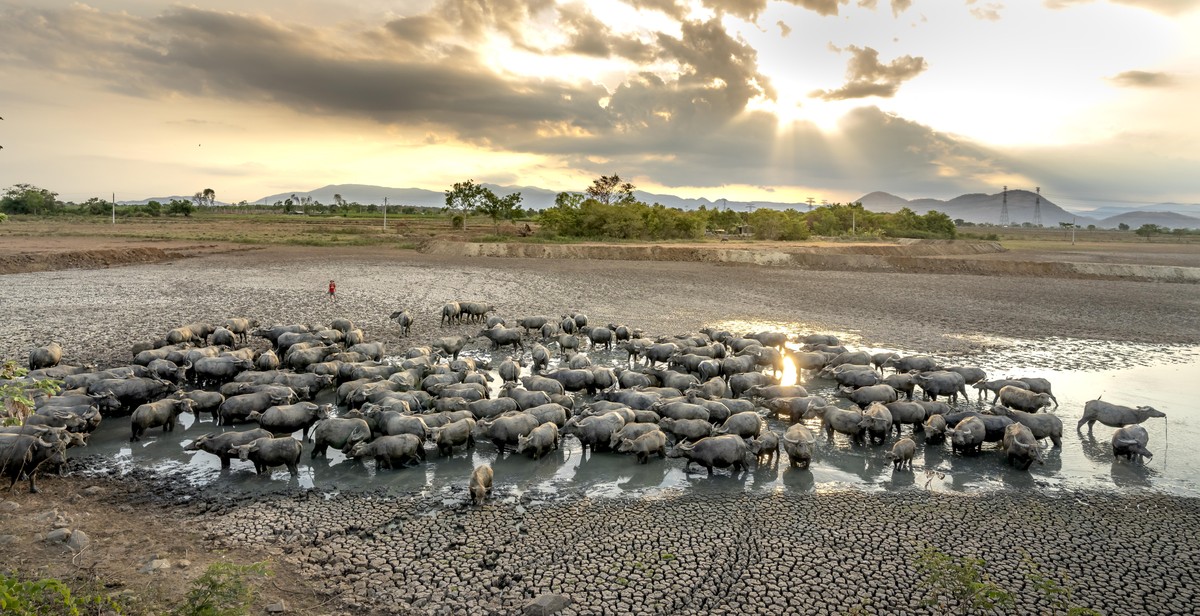How to Build a Buffalo Handling Facility: Designing Safe and Efficient Buffalo Handling Systems
Buffalo handling can be a challenging task, and it requires specialized skills and facilities. Building a buffalo handling facility is a significant investment that requires careful planning and design to ensure safety and efficiency. In this article, I will share my personal experience and expertise in designing and building buffalo handling facilities that are safe, efficient, and easy to use.
The Importance of a Well-Designed Buffalo Handling Facility
Buffalo are large and powerful animals that can become unpredictable and dangerous if not handled properly. Therefore, a well-designed buffalo handling facility is critical to ensure the safety of both animals and handlers. A poorly designed facility can lead to injuries, stress, and even death of both animals and handlers. Additionally, a well-designed facility can increase the efficiency of handling operations, reduce labor costs, and improve animal welfare.
Key Factors to Consider When Designing a Buffalo Handling Facility
Designing a buffalo handling facility requires careful consideration of various factors, including animal behavior, handling equipment, layout, and safety features. The facility should be designed to minimize stress on animals and handlers, provide easy access to animals, and allow for efficient handling operations. Additionally, safety features such as sturdy fences, gates, and chutes should be incorporated into the design to prevent accidents and injuries.
- Animal behavior
- Handling equipment
- Layout
- Safety features
Conclusion
In conclusion, designing and building a buffalo handling facility requires careful planning and consideration of various factors to ensure safety, efficiency, and animal welfare. With the right design, equipment, and safety features, a buffalo handling facility can be a valuable investment for buffalo producers and handlers.

Understanding Buffalo Behavior
Before designing a buffalo handling facility, it is important to understand the behavior of these animals. Buffalo are social herd animals that rely heavily on their group dynamics for survival. Understanding buffalo herd dynamics is crucial in designing a facility that is safe and efficient.
Buffalo Herd Dynamics
A buffalo herd typically consists of a dominant bull, several cows, and their calves. The herd is led by the dominant bull, who is responsible for protecting the group from predators and other threats. The cows are responsible for nurturing and protecting the calves, while also helping to maintain the herd’s social structure.
In a herd, each buffalo has a specific role to play. When designing a buffalo handling facility, it is important to keep these roles in mind. Separating a buffalo from its herd can cause stress and anxiety, which can lead to erratic behavior and even injury.
Buffalo Fight or Flight Response
Buffalo have a strong fight or flight response, which is triggered by perceived threats. When threatened, a buffalo will either charge at the threat or flee from it. This response is hardwired into their instincts, and it is important to keep it in mind when designing a buffalo handling facility.
A poorly designed facility can trigger the fight or flight response in buffalo, which can be dangerous for both the animals and the handlers. It is important to design a facility that allows buffalo to move freely and without obstruction, while also providing enough space to prevent crowding and aggression.
Conclusion
Understanding buffalo behavior is crucial in designing a safe and efficient handling facility. By keeping herd dynamics and the fight or flight response in mind, handlers can design a facility that minimizes stress and anxiety in buffalo, while also ensuring the safety of both the animals and the handlers.

Designing the Facility Layout
Designing a safe and efficient buffalo handling facility requires careful planning and consideration of several factors. The facility size and capacity, location, and corral system design are critical elements that must be considered when designing the layout of a buffalo handling facility.
Determining Facility Size and Capacity
The size and capacity of the facility will depend on the number of buffalo that will be handled and the frequency of handling. It is essential to ensure that the facility is large enough to accommodate the buffalo without overcrowding, which can lead to injuries and stress. A good rule of thumb is to provide a minimum of 50 square feet of space per adult buffalo. It is also crucial to consider the number of workers who will be present during handling and ensure that there is enough space for them to work safely.
Choosing the Right Location
The location of the facility is also an essential consideration. Ideally, the facility should be located in an area that is easily accessible and close to the buffalo’s grazing area. This will minimize the stress and risk of injury during transportation. The facility should also be located away from residential areas to avoid disturbing nearby communities.
Designing the Corral System
The corral system is a critical component of the buffalo handling facility. The corral system should be designed to facilitate the safe and efficient movement of buffalo during handling. The corral system should be designed to minimize the risk of injury to both buffalo and workers. It should be sturdy enough to withstand the weight and force of the buffalo while also providing enough space for workers to move around safely.
When designing the corral system, it is essential to consider the flow of buffalo through the facility. The corral system should be designed to minimize the distance that buffalo need to travel during handling. This will reduce stress and minimize the risk of injury. The corral system should also include holding pens where buffalo can be held before and after handling.
| Facility Layout Checklist |
|---|
| Determine facility size and capacity based on the number of buffalo and frequency of handling |
| Choose a location that is easily accessible and away from residential areas |
| Design a corral system that facilitates safe and efficient movement of buffalo |

Selecting Equipment and Materials
When building a buffalo handling facility, it is important to choose the right equipment and materials to ensure the safety and efficiency of the system. Here are some factors to consider:
Choosing the Proper Handling Equipment
Buffaloes are large and powerful animals that require specialized equipment for safe handling. Here are some essential pieces of equipment to consider:
- Chutes: A sturdy and durable chute system is essential for restraining and guiding buffaloes through the handling facility. Choose a chute with a non-slip floor and adjustable sides to accommodate different sizes of buffaloes.
- Gates: Gates are used to control the movement of buffaloes within the facility. Choose gates that are easy to operate and can withstand the weight and force of the animals.
- Scales: Scales are used to weigh the buffaloes for record-keeping and management purposes. Choose a scale that is accurate and can handle the weight of the animals.
- Headgates: Headgates are used to immobilize the head of the buffalo for veterinary procedures or other tasks. Choose a headgate that is adjustable and can accommodate different sizes of buffaloes.
Selecting Building Materials
The materials used to build the handling facility should be strong, durable, and able to withstand the weight and force of the buffaloes. Here are some materials to consider:
- Steel: Steel is a strong and durable material that is commonly used for building the frame and structure of the handling facility. Choose high-quality steel that can withstand the weight and force of the buffaloes.
- Concrete: Concrete is a sturdy and long-lasting material that is ideal for flooring and walls. Choose a high-strength concrete that can handle the weight and movement of the buffaloes.
- Wood: Wood is a versatile and cost-effective material that can be used for gates, fences, and other components of the handling facility. Choose a sturdy and durable type of wood that can withstand the weather and the force of the animals.
| Equipment/Material | Factors to Consider |
|---|---|
| Chutes | Sturdiness, durability, non-slip floor, adjustable sides |
| Gates | Strength, ease of operation, weight-bearing capacity |
| Scales | Accuracy, weight-bearing capacity |
| Headgates | Adjustability, compatibility with different sizes of buffaloes |
| Steel | Strength, durability, weight-bearing capacity |
| Concrete | Strength, durability, weight-bearing capacity |
| Wood | Sturdiness, durability, weather resistance |

Ensuring Safety and Efficiency
Building a buffalo handling facility requires a careful balance between ensuring the safety of both the animals and the handlers, while also maximizing efficiency in handling and processing. To achieve this, it is important to implement safety protocols and design the facility in a way that promotes efficient handling.
Implementing Safety Protocols
Safety should always be the top priority when handling large animals like buffalo. Implementing safety protocols can help minimize the risk of accidents and injuries. Here are some essential safety protocols to consider:
- Provide adequate training for all handlers
- Ensure all equipment is in good working condition
- Use appropriate safety gear, such as helmets and gloves
- Have an emergency plan in place
- Design the facility with safety in mind, such as having proper lighting and non-slip flooring
Maximizing Efficiency in Buffalo Handling
Efficiency is also a key factor in designing a buffalo handling facility. The more efficiently the animals can be handled and processed, the more profitable the operation can be. Here are some strategies to maximize efficiency:
- Design the facility with a clear flow of movement for the animals
- Use equipment that minimizes stress on the animals, such as hydraulic chutes
- Minimize the amount of time animals spend in holding pens
- Use technology, such as RFID tags, to track and manage the animals
- Ensure that the facility is properly staffed to handle the volume of animals
| Safety Protocols | Efficiency Strategies |
|---|---|
| Provide adequate training for all handlers | Design the facility with a clear flow of movement for the animals |
| Ensure all equipment is in good working condition | Use equipment that minimizes stress on the animals, such as hydraulic chutes |
| Use appropriate safety gear, such as helmets and gloves | Minimize the amount of time animals spend in holding pens |
| Have an emergency plan in place | Use technology, such as RFID tags, to track and manage the animals |
| Design the facility with safety in mind, such as having proper lighting and non-slip flooring | Ensure that the facility is properly staffed to handle the volume of animals |
By implementing safety protocols and maximizing efficiency in buffalo handling, you can create a facility that is both safe and profitable.

Conclusion
Building a buffalo handling facility requires careful planning and consideration of various factors, including the size of the herd, the type of operations you plan to carry out, and the safety of both humans and animals. By following the guidelines outlined in this article, you can design a safe and efficient buffalo handling system that meets your specific needs.
Key takeaways
- Ensure that the facility is designed to minimize stress on the animals and prevent injuries.
- Consider the use of technology to improve efficiency and reduce labor costs.
- Train your staff on proper handling techniques to ensure the safety of both humans and animals.
- Regularly inspect and maintain the facility to identify and address any potential issues.
Final thoughts
Building a buffalo handling facility is a significant investment, but it is crucial for the success of your operation. By designing a safe and efficient system, you can minimize costs, increase productivity, and ensure the well-being of your animals. Remember to consult with experts in the field and follow best practices to ensure that your facility meets all necessary requirements.
